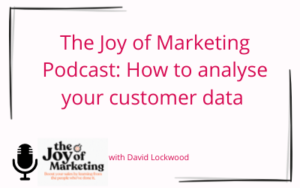In our latest Retail Leaders Forum, we asked multi-channel retailers to share their customer acquisition highlights from what has been a turbulent 12 months to say the least. Here’s what they had to say.
Direct mail is a direct success
Direct mail is traditionally regarded as one of the more expensive acquisition channels, but one that is more likely to bring in customers with a higher future value. This means that many brands use it to recruit customers at breakeven or even at a small loss, banking on repeat purchases to provide a profitable return on investment.
However, over the past 12 months, consumers have flocked to spend online with multi-channel retailers. This new customer base has, in turn, provided a wealth of data for data cooperatives to feed back into direct mail. Therefore, with much improved data and a captive audience at home, many retailers have reported an increase in direct mail response rates, meaning that some have been able to recruit at a profit for the first time in years.
From our own experiences working with clients, we can see that direct mail has proved much more successful this year than it has over the past decade. For some of our clients, response rates have doubled or trebled, while AOVs remain strong and subsequent lifetime value is maturing in line with or even better than historic performance.
Impressive impact from influencer marketing
Meanwhile, brands have reported huge wins from influencer marketing, a type of social media marketing (either organic or paid) involving endorsement and product placement from individuals perceived to have a high level of social influence. From celebrities spotted wearing a brand’s garment, to micro-influencers actively sharing links to a campaign or product, these brand advocates can really help move the needle on brand awareness in a very short space of time. Planning the customer journey as part of paid investments in this channel is important to ensure you can maximise conversion from the traffic generated. Bespoke landing pages, unique offers and robust retargeting strategies work together to yield the best return on an influencer campaign investment.
TV takes off for many this year
For those prepared to meet the relatively high outlay initially, TV has proved a great success over the past year or so, giving brands access to new audiences. Non-prime TV channels – especially those showing sports and entertainment programmes – have also proved effective at building brand awareness.
For one food delivery business in particular, running its ad across a variety of niche broadcasting channels has worked really well in terms of both customer acquisition and brand awareness. Meanwhile, a leading wine merchant has seen great results from its recent TV campaign, which it boosted further by linking up its TV ads with a series of organic and influencer-driven social content.
The recommendation from most retailers is to use a reputable performance media agency, who can work across both small and large-scale campaigns, to help marketers better understand their real-time response metrics, such as CPV (Cost per Visit) as well as build a complementary digital media strategy to ensure brand PPC investment and retargeting activity makes the most of surges in traffic generated by TV media.
Dynamic shopping drives digital sales
Platforms such as Google Shopping have also become popular among multi-channel retailers in recent years due to their impressive reach and low CPAs. But there is a word of warning: a number of brands are finding that Google Shopping in particular is bringing in low-future-value customers. The sheer ease of Google Shopping transactions means that sometimes consumers aren’t even aware which brand they have bought from. They simply search for a particular product online, allowing Google to do the leg work, and within nanoseconds, they have a selection of products from which to choose. However, the fact that these consumers often aren’t aware who they’ve bought from means they are less likely to offer significant future value.
As one retailer has found, an effective alternative to Google Shopping is to use affiliate platforms (such as incremental sales engines) to help facilitate those transactions by providing consumers with a host of direct product comparisons. In return for a CPA of approximately 5% commission per order, this particular retailer enjoys a far higher future value per customer compared with cheaper recruits from Google Shopping.
Product dispatch proves popular
Given the rise in parcels during the pandemic, some retailers have seen huge success from inserting leaflets or catalogues into partner dispatch parcels. By teaming up with other companies with similar brand values and therefore like-minded audiences, retailers are able to achieve a targeted yet much wider reach. While one reported product dispatch response rates of up to 3%, another confirmed over 40% of their recruits came through this channel.
If you are new to this channel, establishing a strong creative and offer proposition in accordance with format or weight restrictions will be the first task. A new creative format is always an option but a less risky approach would be to use a winning design from an existing channel such as inserts, catalogues or direct mail. The logistics involved in working with a brand directly can be complex and time-consuming. If you are unsure who to approach, it’s best to use a media agency with experience in matching you to the most appropriate brands and handling the process efficiently.
Evaluating acquisition across channels
Regardless of the channels you’re using, it’s crucial to consider the impact that one may have on another – as no one channel works in isolation. For example, will direct mail recruits only ever respond to catalogues in future? We know that’s probably unlikely. Part of this is understanding your next-best channel. As one retailer said: “we find that PPC customers don’t tend to come back in through catalogue or paid search again. Instead, they come back in through emails.”
What’s more, basing acquisition measurement on a single factor such as code redemption – which is only attributable to that particular channel – will likely skew your projections for the future value of that customer. Instead, consider using multiple channel measures in combination. Tapestry develops bespoke matrix and attribution reporting for multi-channel retail and ecommerce businesses using first-click, last-click, code redemption, matchback, survey data and whatever other measures are available. The matrix approach removes the hierarchical attribution model often used, providing a complete view of the value and potential of each channel. This gives brands the evidence they need to scale marketing spend up and down across the channels as performance changes over time, thereby optimising their marketing budget and creating deeper engagement with customers.
If you would like to watch David Lockwood, Tapestry Co-Founder and Insight Director explaining this in person, he talks through it in this video: Effective acquisition channels for multi-channel retailers in 2021
You can also read about customer acquisition measurement in our blog: How to measure costs to recruit more profitable customers.
If you’ve had success with a particular channel this year, or would like to improve your marketing strategy in a certain area, we’d love to hear more. Get in touch at [email protected].




